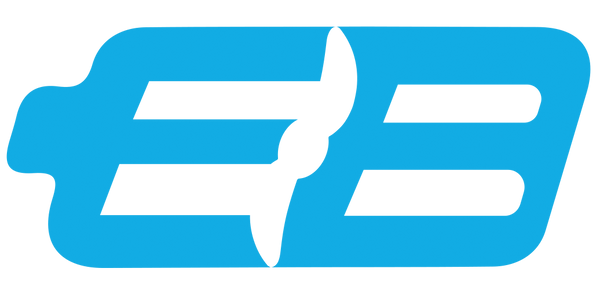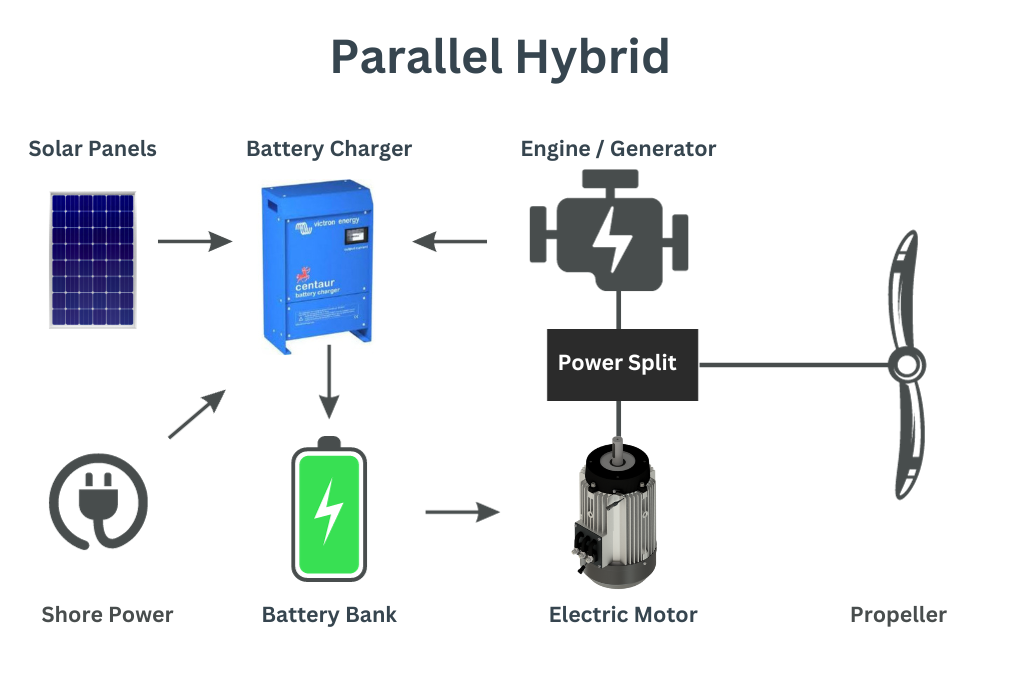What are Hybrid boats?
A hybrid boat refers to a marine vessel that incorporates a combination of different power sources for propulsion. Typically, hybrid boats integrate both conventional internal combustion engines, often fuelled by diesel, and electric propulsion systems powered using stored energy from a battery bank. This dual-power setup aims to leverage the strengths of each system to enhance overall efficiency, reduce fuel consumption, and minimize environmental impact.
Key Components:
- Internal Combustion Engine: A traditional engine, such as a diesel engine, provides the primary power source for the boat.
- Electric Motor(s): Electric propulsion motors are integrated to work alongside the internal combustion engine, providing additional power or serving as the sole power source during certain conditions.
- Energy Storage System: Typically, hybrid boats incorporate batteries or other energy storage systems to store and release electric power as needed. These batteries can be charged through solar, hydro, shore power, or dedicated generators.
- Control System: An intelligent control system manages the distribution of power between the internal combustion engine and electric motors, optimizing performance and efficiency based on the boat's operating conditions.
The hybrid configuration allows the boat to operate in various modes, such as using only the internal combustion engine, relying solely on electric power for short distances, or combining both systems for maximum efficiency. Hybrid boats aim to provide improved fuel efficiency, reduced emissions, and increased flexibility in different navigational scenarios, making them a popular choice for eco-conscious boaters and those seeking versatile and sustainable marine transportation solutions.
The two main hybrid systems are series/serial and parallel.
Is Hybrid right for me?
The viability of a Hybrid system depends significantly on the specific type of craft, the engine type, and its usage patterns. For high-speed, powerful boats with consistently well-loaded engines, a hybrid may not provide absolute benefits. However, in scenarios where powerful boats operate at low loads for extended periods or experience prolonged engine idling with access to charging points, hybrids can enhance fuel economy.
Despite the additional components and costs associated with hybrid installations, the trade-off must be considered against the potential gains in operating efficiency. Beyond fuel savings, hybrids offer additional advantages, such as the elimination of engine idling, instantaneous use of electric motors, zero power consumption when stationary, and increased range (compared to 100% electric). Opportune shore charging opportunities can replenish the battery bank, reducing overall fuel consumption. Moreover, alternative energy sources like wind or solar can contribute to charging the battery bank, while sailing craft can regenerate energy from a free-wheeling propeller.
Which type of hybrid?
Embarking on the journey of selecting the power source for your boat demands a nuanced understanding of the advantages and trade-offs associated with diesel, parallel hybrid, and serial hybrid systems.
Diesel:
In the realm of diesel-powered boats, simplicity is key. If we consider a 100hp engine fixed at the shaft, these vessels offer reliability and cost-effectiveness. However, their efficiency takes a hit at lower speeds, reaching approximately 10% at 1,200 RPM (typical canal boat case). Yet, their steadfastness makes them the go-to for those valuing a straightforward and economical solution.
Parallel Hybrid:
Enter the parallel hybrid, a seamless blend of diesel and electric power. With an engine size matching that of diesel (100hp) and fixed at the shaft, these hybrids maintain the reliability of their diesel counterparts. They shine, though, in terms of efficiency, reaching around 15% at 1,200 RPM. However, the addition of batteries and a mid-size motor/controller comes at an extra cost.
Serial/Series Hybrid:
On the other hand, serial hybrid boats feature an electric motor as the primary means of propulsion, with an internal combustion engine acting solely as a generator. This design offers flexibility in terms of engine placement and can optimize efficiency at various loads. Serial hybrids excel in scenarios where electric power is the primary driver, allowing for reduced emissions and improved fuel efficiency during low-speed operation.
However, serial hybrid boats are not without drawbacks. The complexity of additional components, including the necessity to scope a larger electric motor (compared to a parallel hybrid) and a generator, contributes to higher upfront costs. The reliance on electrical systems poses a potential vulnerability, as a failure in the motor or controller can disable the entire craft. Additionally, the efficiency gains may be compromised at high speeds or when the boat operates solely on internal combustion power due to the higher power requirements compared to parallel hybrids.
As you navigate the seas of choice, the diesel offers simplicity and affordability, the parallel hybrid enhances efficiency with a modest cost increase, while the serial hybrid presents versatility but demands a higher investment. Your decision should align with your priorities, whether it be reliability, fuel efficiency, or the initial cost outlay. Each option unfurls a unique chapter in the tale of marine propulsion, waiting for you to script your maritime adventure.


